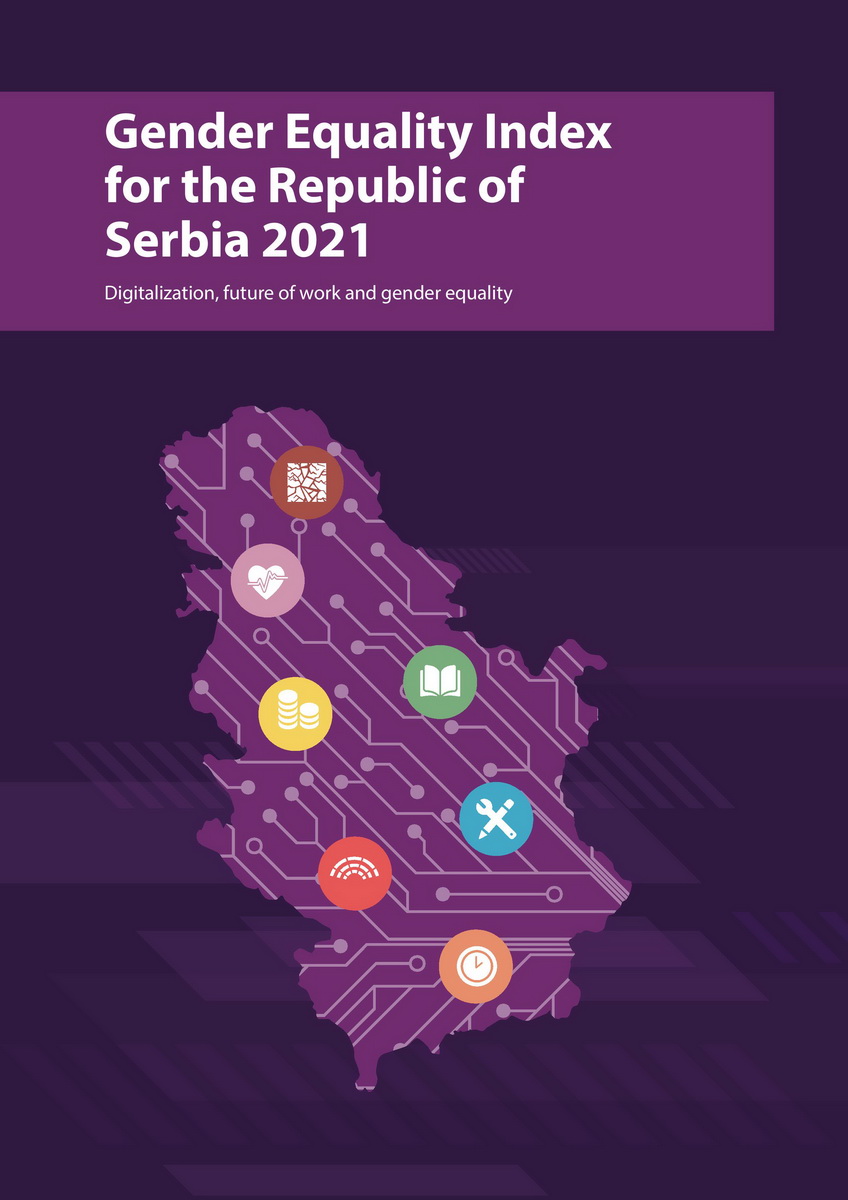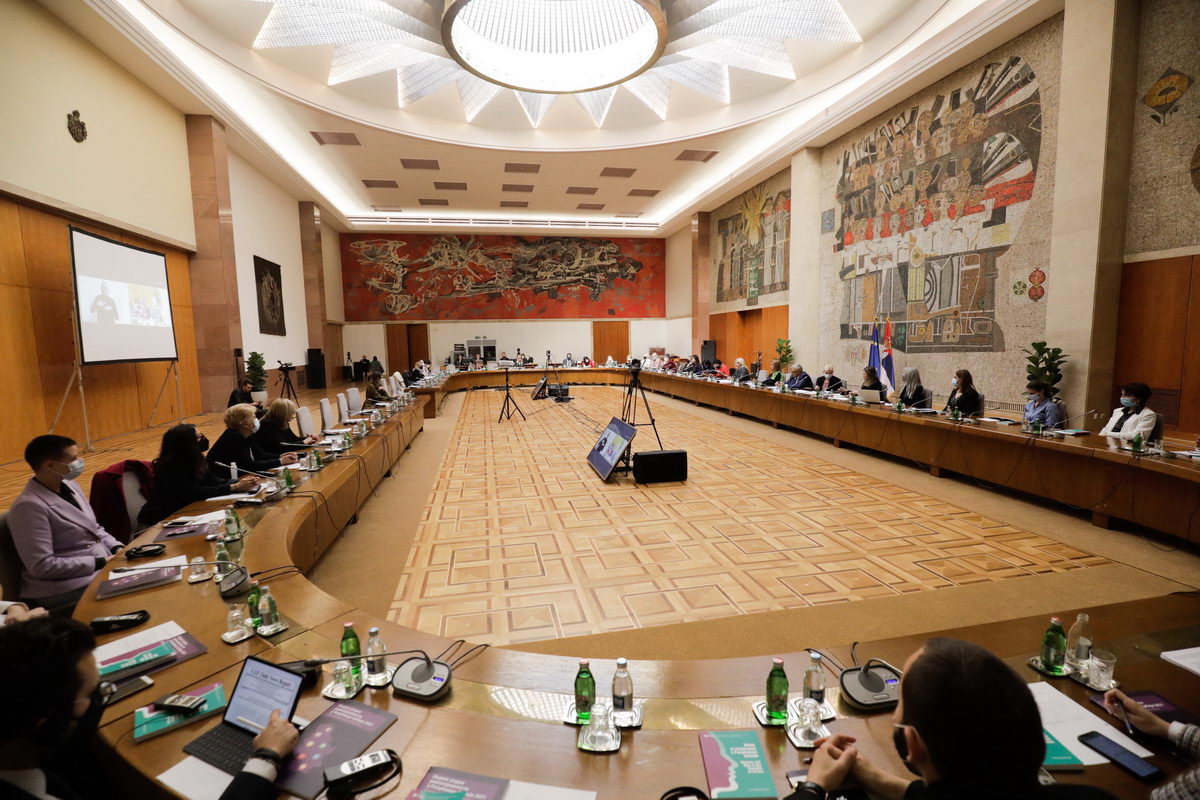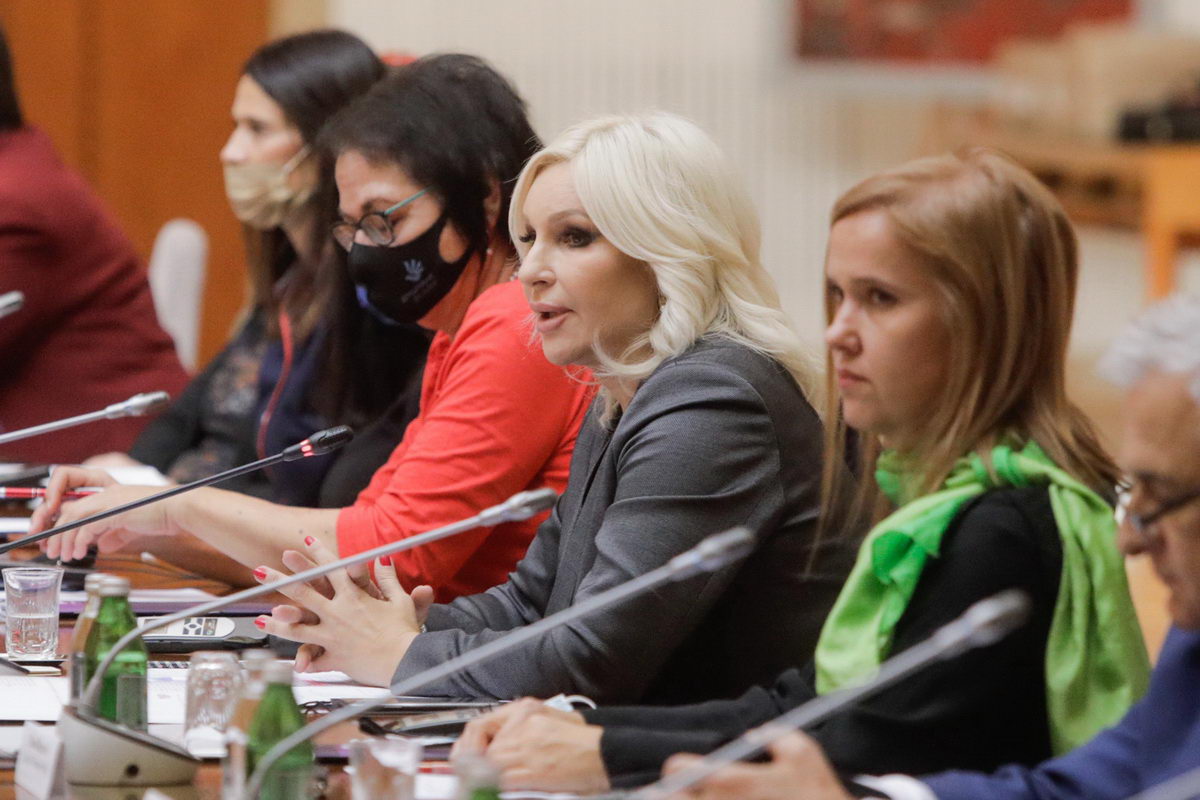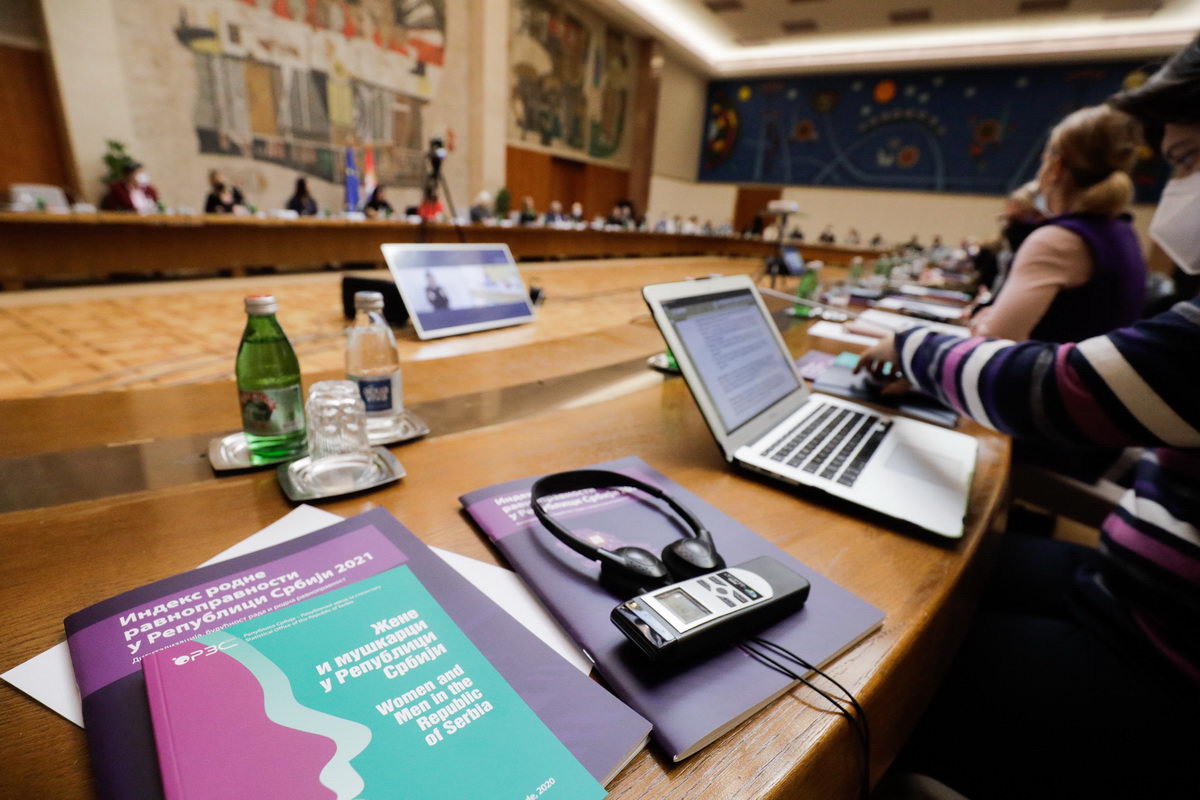 On 20 October 2021 the Social Inclusion and Poverty Reduction Unit of the Government of the Republic of Serbia presented the third Gender Equality Index in the Republic of Serbia 2021, based on data from 2018. The value of the Gender Equality Index in the Republic of Serbia is 58.0 points, an increase of 5.6 points compared to the first Gender Equality Index from 2016.
On 20 October 2021 the Social Inclusion and Poverty Reduction Unit of the Government of the Republic of Serbia presented the third Gender Equality Index in the Republic of Serbia 2021, based on data from 2018. The value of the Gender Equality Index in the Republic of Serbia is 58.0 points, an increase of 5.6 points compared to the first Gender Equality Index from 2016.
The Gender Equality Index in the Republic of Serbia is the result of cooperation between the Coordination Body for Gender Equality of the Government of the Republic of Serbia, Social Inclusion and Poverty Reduction Unit of the Government of the Republic of Serbia, Statistical Office of the Republic of Serbia, United Nations Entity for Gender Equality and the Empowerment of Women (UN Women), SeConS Development Initiative Group and European Institute for Gender Equality (EIGE).
“Serbia is the first country outside the European family that has calculated and published the Gender Equality Index for the Republic of Serbia in 2016”, said Miladin Kovačević, Director of the Statistical Office of the Republic of Serbia, and expressed his expectation that the joint work on the calculation of the Index will continue in the coming years. “This provides for the monitoring of data, status and impact of policies in the field of gender equality”, concluded Kovačević.
As elaborated by Dragana Jovanović Arijas, Manager of the Social Inclusion and Poverty Reduction Unit of the Government of the Republic of Serbia, the Gender Equality Index covers the domains of work, money, knowledge, time, power and health. “This year’s thematic focus is particularly interesting in the context of the current epidemiological crisis, dealing with digitalisation and the future of labour”, said Jovanović Arijas and noted that the Index was being prepared during the time of adoption of the new Law on Gender Equality, Strategy for Gender Equality 2021-2030, and amendments to the Law on the Prohibition of Discrimination. “Therefore, the Gender Equality Index will be extremely important for drafting strategic and action documents”, noted Jovanović Arijas.
 According to Maruša Gortnar, Head of Operations of the European Institute for Gender Equality (EIGE), since the start of the calculation of the index in Serbia, this instrument has become one of the main initiatives in the field of gender equality. “EIGE is particularly proud of the opportunity to share the knowledge, tools and methods in the region, and now the Gender Equality Index is also being calculated in North Macedonia, Albania and Montenegro”, said Gortnar. She explained that the result of 58 points indicates continuous, albeit slow progress in improving gender equality in Serbia, while the greatest progress was registered in the domain of power.
According to Maruša Gortnar, Head of Operations of the European Institute for Gender Equality (EIGE), since the start of the calculation of the index in Serbia, this instrument has become one of the main initiatives in the field of gender equality. “EIGE is particularly proud of the opportunity to share the knowledge, tools and methods in the region, and now the Gender Equality Index is also being calculated in North Macedonia, Albania and Montenegro”, said Gortnar. She explained that the result of 58 points indicates continuous, albeit slow progress in improving gender equality in Serbia, while the greatest progress was registered in the domain of power.
“The results of the Index show that if we continue at this tempo, we may achieve the goal in 59 years. Therefore, it is our obligation to envisage the needs of today’s girls, that will surely change in the future”, said Milana Rikanović, Head of the UN Women Office in Serbia. “Since the calculation of the index has shown that we do not have data on unpaid labour, I am particularly proud that the new Law on Gender Equality envisages the obligation of institutions to collect and publish data on unpaid labour”, said Rikanović and noted that it is precisely due to the progress made in the domain of power that “it is important that the women who represent us are fighting to achieve gender equality”.
Gordana Čomić, Minister of Human and Minority Rights and Social Dialogue, said that the index measures whether we as a society have adopted regulations prohibiting behaviour based on the stereotype that women and men do not have an equal legal status, that they do not have equal rights, and whether institutions are engaged in the practical application of regulations prohibiting behaviour based on prejudice, to improve the lives of both men and women. “The increase of 18.5 related to power shows that nothing can stop an idea whose time has come, whereas to achieve the idea, we need to turn power over someone into power for something”, said Čomić and noted the importance of measuring and calculating data with the aim of improving the current situation.
 Prof. dr Zorana Mihajlović, Deputy Prime Minister of the Republic of Serbia and President of the Coordination Body for Gender Equality said that since its first calculation the Gender Equality Index has been a guideline for what we need to do to improve the situation. “Thus, this Index will also be a basis for changes or new legislative frameworks. I believe we have enough strength, energy and political support to make this work far more effective”, noted Mihajlović and explained that the good result in the domain of power provides great support, while the data shows problems in the domains of money and time. “Women are still paid far less and spend far more time in unpaid work, and crises such as the epidemic show in particular how vulnerable the conditions of gender equality are”, said Mihajlović.
Prof. dr Zorana Mihajlović, Deputy Prime Minister of the Republic of Serbia and President of the Coordination Body for Gender Equality said that since its first calculation the Gender Equality Index has been a guideline for what we need to do to improve the situation. “Thus, this Index will also be a basis for changes or new legislative frameworks. I believe we have enough strength, energy and political support to make this work far more effective”, noted Mihajlović and explained that the good result in the domain of power provides great support, while the data shows problems in the domains of money and time. “Women are still paid far less and spend far more time in unpaid work, and crises such as the epidemic show in particular how vulnerable the conditions of gender equality are”, said Mihajlović.
As stated by Dragana Đoković Papić from the Statistical Office of the Republic of Serbia, the use of gender-sensitive statistics increases the understanding of social phenomena and improves their analysis. “The Gender Equality Index represents a measurement instrument for determining the status of women and men and gender equality, as well as changes in society in key fields and domains of gender equality”, explained Đoković Papić.
 “The Gender Equality Index measures both the level of achievement and the gender gap compared to the first measurement”, said prof. dr Marija Babović, Programme Director of the SeConS Development Initiative Group and noted that Serbia registers an increase of 5.6 points, but that progress during the past two years has been slower compared to the first two years of measurement. “Compared to the European Union, in the latest reporting period the gap was reduced by one point”, said Babović. She explained that three processes can be identified regarding progress. One is continuous, steady progress registered in the domains of power and work, followed by fields of oscillating changes in the domains of money and knowledge, and areas that register stagnation, such as the domains of time and health.
“The Gender Equality Index measures both the level of achievement and the gender gap compared to the first measurement”, said prof. dr Marija Babović, Programme Director of the SeConS Development Initiative Group and noted that Serbia registers an increase of 5.6 points, but that progress during the past two years has been slower compared to the first two years of measurement. “Compared to the European Union, in the latest reporting period the gap was reduced by one point”, said Babović. She explained that three processes can be identified regarding progress. One is continuous, steady progress registered in the domains of power and work, followed by fields of oscillating changes in the domains of money and knowledge, and areas that register stagnation, such as the domains of time and health.
Prof. dr Marijana Petrović from the Faculty of Transport of the University of Belgrade presented the results of the thematic focus of the Gender Equality Index “Digitalisation and the Future of Labour”, containing three segments: Use of ICT, digital skills and gender equality, Digital transformation of the world of labour and gender equality, and Broader consequences of digitalisation on human rights and violence against women. “The gender gap in the use of the internet is present in Serbia among elderly and less educated persons, with noted gender patterns. Thus, women use the internet more for communication and posting content, while men are oriented more towards entertainment”, said Petrović and noted that gender differences in digital skills are not pronounced, but that the digital skills of the population of Serbia are below the European average.
 Government of the Republic of Serbia
Government of the Republic of Serbia















 pdf [271 KB]
pdf [271 KB]
Leave a Comment